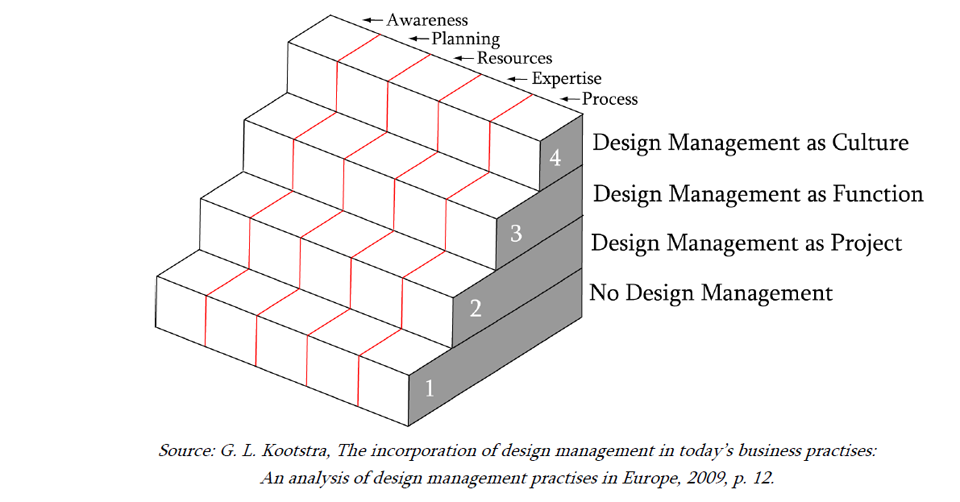Everybody is slowly accepting the reality that Agile is here to stay. It may not stay in the form of a Scrum framework during the
next decade, but most definitely through some PM framework which will reflect upon core Agile values. While
Scrum community is steadily overcoming the challenges which developers are facing, it is strangely silent on
topics regarding how to implement modern UX practices into a Sprint.
Scrum Guide says that the team should
consist of all the people needed to finish the work without depending on other people or teams. In reality, that
usually ends up with having only one designer in a team with eight software engineers and quality assurance engineers.
Trying to fit most Scrum-based organizations into
DME Staircase Model, most would be located on a third staircase, treating design management
as a function.
Some Scrum teams would even rank as low as staircase two, without even having a designer after a pre-sprint phase. That case
is common when building banking or invoicing products, where all design rules for forms are defined at product
inception, with Business Analysts defining the whole information architecture afterward and not putting much
thought into overall UX quality. Just compare that ratio to companies like IBM, which are making design thinking
a part of their corporate culture and striving to have one designer per one front-end developer.
Importance of Design
In this article, I will not preach about the importance of design for ROI. I suggest
just looking at the graphic below and article below.
Why do User Experience Designers Hate Scrum? There are many problems when running user experience
design in a Scrum team. Some are communicational and organizational, finely discussed in
an article by Cornelius
Parkin. Other problems are simply connected with unrealistic work overload which results in a lack of time
needed for design thinking process. Whether your sprint lasts for a week or a month, the scope of work for designers
is usually too massive in order to support the development capabilities.
I have seen designers struggling to provide prototypes in each sprint, often changing them during the sprint itself when
development runs into design implementation impediment because there was a lack of communication. And then completely
re-developing the experience a few months later, after a lot of negative user feedback amasses. The worst part
of the story is that it's not even their own fault. It’s the fault of the process.
Nowadays, great UE design requires more than just creating wireframes and prototypes. It requires thinking about the whole
user journey wearing multiple personas hat. It requires real user interviews. A
case study by Nielsen and Norman group says that Agile panelists agree on the importance
of validating designs. Unfortunately, most teams don’t conduct user research on a consistent basis, if at all.
People cite tight deadlines and staffing shortages as reasons for deficiencies in user-centered activities. What
is worse, many Scrum based organizations are not even taking steps to try changing that, accepting copy-paste
experiences as an essential part of their products.
What Can You Do to Help Your User Experience Designers?
If you want your organization to be in the top
1% in terms of UX quality, you need to embrace design management as a part of your culture. That means moving
away from Scrum imposed boundary of a team being cross-functional, in a sense that designers need to be a part
of the team. You need to introduce a design thinking framework for your design crew.
Having design crew work in their own iterations has a few cons:
1. You need to start treating design as a prerequisite for PBI before adding it to a sprint.
2. You need to keep the communication flowing between the teams (backlog grooming become multi-team activity)
3. Obviously, you need to manage dependencies in order to handle stakeholders expectations about the timeline.
Regarding the design thinking framework choice, I kindly recommend Google Design Sprints. It’s an excellent framework for
producing UX solutions in iterations. Understanding the concepts of Design Sprint should be fairly easy for an
experienced Scrum Master, so go ahead and download
Design Sprint Methods playbook.
Design Sprints are a framework for teams of any size to solve and test design problems in 2-5 days. The idea of sprints originates with the Agile framework. The idea of design thinking was developed at IDEO and the d.school at Stanford.
In the Nielsen Norman case study, I have already mentioned above, the author suggests that UX must work at least one step ahead of
the Sprint. I suggest keeping Google Design Sprint in sync with Scrum Sprint, but doing Design Sprint at least
two Scrum Sprint upfront in order to avoid organizational hazards.
Transforming your organization into a place which treats superb design as a part of its culture is a huge project without shortcuts,
requiring a change of mindset on all scales of the organization. The first step is realizing the existing pitfalls
and adjusting the process, so people responsible for delivering the design have the environment to produce to
their best capabilities. I am not saying that the solution I have described above is a golden bullet for all
the design problems within an organization, and in case you have any suggestions or comments, feel free to reach
out on
Twitter or
Linkedin.

